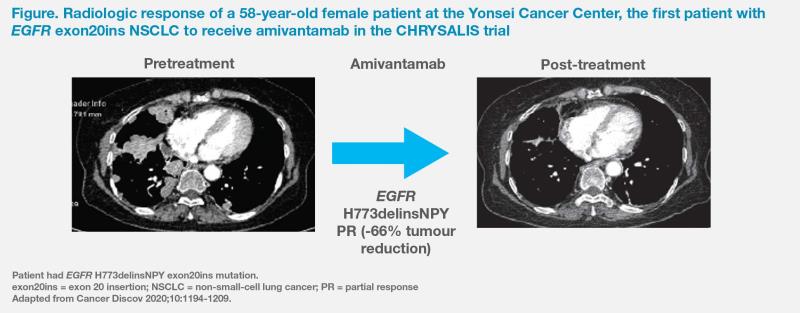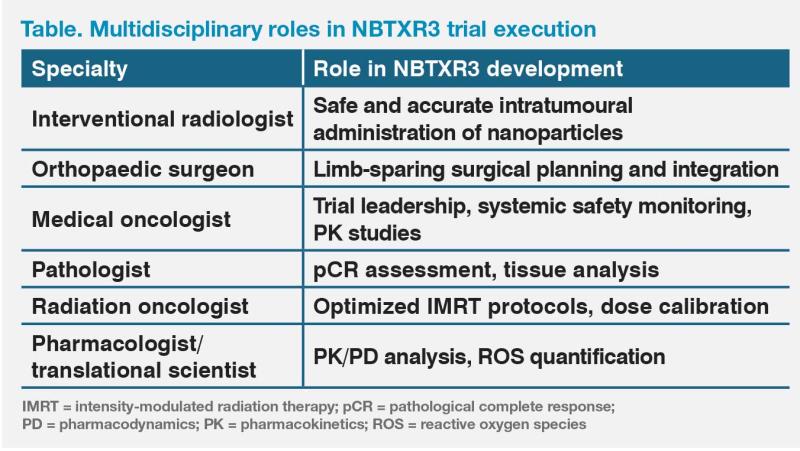Success factors in oncology drug development: Regional perspectives on amivantamab and NBTXR3









At an industry-sponsored symposium during the European Society for Medical Oncology Targeted Anticancer Therapies Asia Congress (ESMO TAT Asia) 2025 in Hong Kong, regional experts reflected on pioneering oncology drug development. Dr Jii Bum Lee of Yonsei Cancer Center, Seoul, Republic of Korea, discussed the unique translational and clinical journey of amivantamab, an EGFR-MET bispecific antibody, which was first established as a treatment for non-small-cell lung cancer (NSCLC) with EGFR exon 20 insertion (exon20ins) mutations. Dr Herbert Loong of the Chinese University of Hong Kong shared the experience of advancing NBTXR3, a novel hafnium oxide–based nanoparticle radiosensitizer, into the clinic, underscoring the necessity of multidisciplinary collaboration for success.
From research to reality: Developing amivantamab
A patient-driven milestone in NSCLC treatment
“The breakthrough with amivantamab originated not simply from bench research, but from a single patient at Yonsei Cancer Center,” shared Lee. “A 58-year-old female patient with previously treated advanced NSCLC harbouring EGFR exon20ins mutation – a driver mutation historically difficult to detect and target – was the first to receive amivantamab after being enrolled in the landmark phase I CHRYSALIS trial. After receiving a dose of amivantamab, the patient achieved a partial response with 65 percent tumour shrinkage, and was progression-free for 23 months.” (Figure) [Cancer Discov 2020;10:1194-1209; J Clin Oncol 2021;39:3391-3402]

“The case exemplified how real-world patient care can lead to clinical innovation, initiating a sequence of trials that has since transformed the therapeutic landscape,” she commented.
Since the discovery of EGFR mutations in 2004, various attempts at targeting exon20ins mutations and improving outcomes have been made, but with limited success. [Ther Adv Med Oncol 2023;15:17588359221146131] Unlike common EGFR mutations, exon- 20ins confers resistance to first- and second-generation tyrosine kinase inhibitors (TKIs), limiting patients’ options to chemotherapy. [Cancer Discov 2021;11:2145-2157; Signal Transduct Target Ther 2019;4:5]
CHRYSALIS: From proof of concept to clinical practice
“Alongside preclinical proof that amivantamab blocks both EGFR and MET pathways while engaging immune effector cells, the open-label, dose-escalation and dose-expansion CHRYSALIS trial provided critical evidence to support the approval of amivantamab in patients with NSCLC harbouring exon20ins mutations,” said Lee. [Cancer Discov 2020;10:1194- 1209; J Clin Oncol 2021;39:3391-3402]
CHRYSALIS was the first-in-human study that evaluated the efficacy, safety and pharmacokinetics of amivantamab administered intravenously in patients with advanced NSCLC. Cohort D of the trial evaluated 81 patients with EGFR exon20ins mutation who had previously received a median of two lines of therapy, including platinum-based chemotherapy. [J Clin Oncol 2021;39:3391-3402; NCT02609776]
Primary endpoint results showed that amivantamab was associated with an overall response rate (ORR) of 40 percent, with a median duration of response of 11.1 months, and a median progression-free survival (PFS) of 8.3 months. Amivantamab had a tolerable safety profile, with rash (86 percent) and infusion-related reactions (66 percent) being the most common adverse events reported. [J Clin Oncol 2021;39:3391-3402]
These results demonstrate amivantamab’s clinically meaningful efficacy and tolerable safety profile in patients with EGFR exon20ins NSCLC who have progressed after platinum-based chemotherapy, ultimately supporting approval by the US FDA in May 2021, a milestone that redefined exon20ins as an actionable target. [Ther Adv Med Oncol 2023;15:17588359221146131; Rybrevant Hong Kong Prescribing Information]
“The CHRYSALIS results represent a reverse trajectory in drug development,” commented Lee. “Rather than the conventional ‘bench-to-bedside’ process, the experience of the first patient treated at Yonsei Cancer Center catalyzed refinement of the drug and trial design, exemplifying a ‘bedside-to-bench and back again’ cycle.”
From CHRYSALIS to MARIPOSA: Expanding amivantamab’s impact through combination
Following proof of improved prognosis in patients with previously treated NSCLC with exon20ins mutations, researchers recognized the broader potential of amivantamab in treatment-naïve populations. Combined blockade of EGFR and MET signalling appeared promising in more prevalent EGFR-mutant NSCLC subtypes, particularly when paired with the third-generation EGFR TKI, lazertinib. [Cho BC, et al, WCLC 2022, abstract P1.16-01; J Thorac Oncol 2022;17:558- 567; N Engl J Med 2023;389:2039-2051; N Engl J Med 2024;391:1486-1498; Nat Rev Clin Oncol 2025;22:95-116]
“Incidentally, one of the key investigators of CHRYSALIS, Professor Byoung Chul Cho, was also leading the phase I/ II LASER201 study, which demonstrated the efficacy and safety of lazertinib in patients with advanced EGFR T790M-positive NSCLC after previous EGFR TKI therapy,” shared Lee. [J Thorac Oncol 2022;17:558-567] “Findings from the two studies eventually led to investigations of the combination of amivantamab and lazertinib in the front-line setting.” [N Engl J Med 2024;391:1486-1498; Nat Rev Clin Oncol 2025;22:95-116]
MARIPOSA was a phase III trial comparing amivantamab plus lazertinib vs osimertinib in treatment-naïve patients with advanced EGFR-mutant (exon 19 deletion or L858R) NSCLC. Results showed that median PFS improved by 7.1 months (23.7 vs 16.6 months) with amivantamab plus lazertinib (hazard ratio, 0.70; 95 percent confidence interval, 0.58–0.85; p<0.001). Overall survival (OS) also showed a trend towards improvement, with median OS projected to be >12 months longer than with osimertinib. [Cho BC, et al, ESMO 2023, abstract LBA14; Yang JCH, et al, ELCC 2025, abstract 4O]
Multidisciplinary partnership in drug development:
NBTXR3 as a radiosensitizer Radiosensitizers: Enhancing radiotherapy’s potential
“NBTXR3 is a first-in-class hafnium oxide nanoparticle injected directly into tumour tissue to increase local electron density, enhancing ionizing radiation effects and amplifying DNA damage and tumour kill,” explained Loong. “Importantly, its density and electron content enable superior energy deposition in tumour tissue, without increasing systemic toxicity.” [Theranostics 2018;8:1824-1849]
“The initial focus of NBTX3 was in preoperative management of soft tissue sarcomas [STS], a group of rare, heterogeneous malignancies often managed in the extremities with limb-sparing surgery plus radiation,” he explained. “In this setting, radiosensitization may offer the dual benefits of higher tumour control and preservation of limb function.” [Scientific World Journal 2013;2013:852462; Curr Treat Options Oncol 2022;23:68-77]
An important aspect of NBTXR3 demonstrated preclinically was the reassuring observation that the nanoparticles remained well contained within the tumour after injection, without significant leakage into surrounding tissues. It was also shown to have consistent intratumoural residency from 6 hours post-injection through at least day 14, with little evidence of seepage. This containment, coupled with the chemically inert nature of hafnium oxide, supported the favourable safety profile of NBTXR3 by minimizing the risk of off-target inflammation or toxicity. These findings provided a robust proof-of-concept, supporting the advancement of NBTXR3 into clinical evaluation for sarcomas. [Future Oncol 2012;8:1167-1181]
Initial STS clinical trials with NBTXR3: Navigating complexity across disciplines
Translating this principle into the clinic, the first-in-human phase I trial in advanced STS confirmed the feasibility and safety of intratumoural administration of NBTXR3. A dose-escalation approach established that administering NBTXR3 with radiotherapy maximized local tumour shrinkage while maintaining tolerability. Importantly, the study reported no new or unexpected toxicities, reinforcing that radiosensitization could be effectively pursued with this novel nanoparticle platform. [Bonvalot S, ASCO 2014, abstract 10563]
“This led us to conduct a multicentre phase II/III study that evaluated the safety and efficacy of NBTXR3 activated by radiotherapy vs radiotherapy alone in 223 patients with locally advanced STS,” shared Loong. “The primary endpoint was pathological complete response [pCR], which is believed to be prognostic of improved outcomes.” [Lancet Oncol 2019;20:1148-1159]
Results showed pCR rates of 16 percent with NBTXR3 plus radiotherapy vs 8 percent with radiotherapy alone. R0 resections were also more frequent in the NBTXR3 arm (77 vs 64 percent), with no difference in wound complications or radiologic imaging outcomes between groups.
“Patients with high-grade tumours derived the greatest benefit, with higher pCR rates vs radiotherapy alone,” he added. “This is particularly important since high-grade sarcomas are most prone to metastasis and treatment failure.”
“Developing something novel like this, implementing it in clinical trials and achieving such results would not be possible without seamless collaboration across multiple specialties,” emphasized Loong. “For instance, interventional radiologists handled intratumoural injections, ensuring accurate localization. Orthopaedic surgeons prepared patients and addressed operative impacts. Medical oncologists like me coordinated the trial, integrated pharmacokinetics, and orchestrated patient care journeys. Pathologists analyzed biopsy and resection samples with rigorous assessment of pCR endpoints. Such coordinated framework not only proved feasible, but also led to international recognition, establishing NBTXR3 as a first-in-class radiosensitizer with encouraging efficacy and manageable safety.” (Table)

Expanding horizons: From sarcomas to lung cancer
“Encouraged by sarcoma trial outcomes, research has extended into the use of NBTXR3 in more common malignancies. An ongoing international phase III trial in unresectable stage III NSCLC combines NBTXR3 injection with concurrent chemoradiation, followed by immunotherapy,” said Loong. [NCT06667908] “Early feasibility data suggest integration is possible, opening the door to radiosensitizer applications across multiple solid tumours."
Summary
Successful oncology drug development relies on seizing clinical insights and fostering multidisciplinary teamwork. The story of amivantamab illustrates how patient-driven opportunities and regional-global partnerships can rapidly advance novel therapies. NBTXR3’s progress demonstrates that successful innovation depends on integrated cross-specialty collaboration. These success stories demonstrate the feasibility of drug development in the Asia-Pacific region, which is increasingly contributing to the global drug development field.